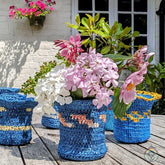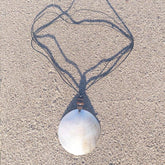Trash to Treasure - Creative Reuse Part 1
Upcycling And Recycling: What’s The Difference?
The difference between upcycling and recycling is that the latter takes materials like paper, metal, plastic, or glass and breaks them down by pulping or melting etc and then remoulds the raw material into a new product. A good example is taking plastic recovered from the ocean and turning them into swimming costumes> Hence an entirely new product is created.
This is not the case with upcycling, where products are not broken or melted down, they are simply ‘reassembled’ to make new.
Upcycling represents a variety of processes by which discarded “old” products are modified and get a second life as they’re turned into a “new” product. In this way, thanks to the mix and aggregation of used materials, components and items, the end result is a “new product” with more value than the original value of the sum of all its components. In other words, upcycling is about materials or items that get to be re-adapted and/or re-purposed in a creative way, and whose lifespan is, therefore, expanded.
Since upcycling repairs and repurposes materials many products have the potential to be upcycled. Hobbyists and professionals across many industries create new products from old ones to increase sustainability and reduce costs.

What can be Upcycled?
Fashion
The production process of the textile industry uses vast amounts of energy, water and chemicals. It’s very polluting to the environment and its supply chain often isn’t an ethical one. Upcycling provides a neat solution that. While upcycling has been a part of the artisanal trade for millennia, thanks to pressure from ordinary people choosing where to spend their money, large companies are waking up. Capitalism by its very nature is trading for profit, providing people with what they want at a price they are willing to pay. It is, therefore, a natural evolution that big companies are realising that there is money to be made by being more ethical than they might currently be. A good example Patagonia. They have long touted their environmental credentials and are known for caring for the environment. Indeed, they put their money where their mouth is by buying tracts of land to prevent it from being developed. It is no surprise then that they realise they can do more. Now they have a scheme where damaged clothes no longer fit for purpose are “disassembled” and their textiles get reused for the creation of some other piece of clothing or other item. We support this and hope that more such companies follow suit.
Furniture:
Re-using wood is nothing new, particularly hardwoods, but now it is becoming more and more available in the UK. For example in Indonesia and the Philippines old teak wood fishing boats are broken down into their re-usable planks re-purposing into furniture. What is particularly charming is that often they do not remove all the layers of paint applied over decades making each piece unique with their own special charm. There are no limits to the power of creativity in upcycling furniture and other household items.
At RainbowLife we have a range of upcycled furniture repurposed from old Balinese teak boats. https://rainbowlife.co.uk/collections/furniture-wood
Industrial:
There are established manufacturing organizations reusing the waste in products that re-enter consumer cycles. Examples of this are companies like Terracycle that creates waste collection programs for waste that is impossible or difficult to recycle and ends up producing things like park benches or pencil cases or tote bags from food and drink packaging.
Architectural:
Upcycling habits in the industrial sector are rising as the desire to produce with a zero waste mindset grows. The practical-minded visionaries, William McDonough and Michael Braungart in ‘The Upcycle: Beyond Sustainability--Designing for Abundance’, envision a world where industrial production creates little waste and no toxic chemical pollution. This aspirational world is based on the concept of creating with recycling and reuse in mind. We don't just reuse resources with greater effectiveness, we endeavour to improve them as we use them. The questions of resource scarcity and sustainability are questions of design. They believe that design should be non-destructive and harmonious with the environment and model the greatest designer of all: Mother Nature herself.
What are the benefits of Upcycling?
If we look at upcycling from a large-scale perspective, we can say that it contributes to the reduction of CO2 emissions. This is achieved not only because the lifetimes of the materials used are extended, but also because it contributes ultimately to reducing carbon emissions by extending the lifetimes of used materials, components and products. Upcycling helps to create a circular economy, where materials can be constantly reused and not turn into waste. It is a practice that has been used throughout history as a means of reducing waste in an inexpensive way.
On a smaller scale let’s look at benefits to individual wellbeing:
Upcycling can really be a great form of self-therapy as upcycling your ‘stuff’ be that your clothes, your furniture, or your rubbish provides mental health benefit as gives a sense of achievement. With all the science confirming how close we are to various environmental tipping points many are genuinely concerned about the legacy our generation is leaving for our kids and grand-kids.
If you are struggling with depression, anxiety or just a general malaise it is well documented that being creative can help at those times. Upcycling: where you are creating something out of waste, the rebirth of something new that would otherwise be lost, gives an added sense of personal worth and self-purpose.
Upcycling gives you the opportunity to make something that is truly one-of-a-kind and unique to you. You can paint something, sew something, or decoupage something so that it reflects your personality and individuality.
Upcycling doesn’t come naturally to everyone so, if you are new to this, don’t beat yourself up that it seems just too tricky. I suggest you take a look at some sites, and YouTube videos for ideas & inspiration and start with something small like covering a tin can in a wrapping paper offcut. Gradually you will start to look at rubbish in a different way- you will see purpose & function. You may even find yourself rummaging through your neighbour’s skip (that’s an admission). Creativity will flow and you will find upcycling enjoyable.












Leave a comment
All blog comments are checked prior to publishing